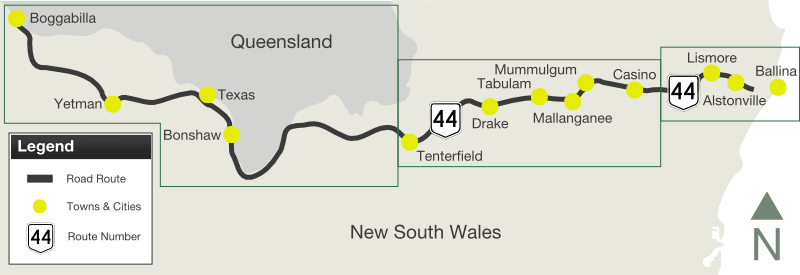
 |
Bruxner Highway (National Route 44) (Decommissioned) |
Statistics:
Route Numbering:

General Information:
The Bruxner Highway is named after Michael Bruxner, member for Northern Tablelands and Tenterfield from 1920 to 1962, leader of the New South Wales Country Party for almost all that period and Deputy Premier and Minister for Transport from 1932 to 1941. Mr Bruxner grew up in the Tenterfield area.
The Bruxner Highway is the State's most northerly highway from the coast to the interior plains.
The western section from Tenterfield to Boggabilla was never officially signposted as NR44 as planned, as the route was never fully sealed at the western end, however this section is now fully sealed.
Multiplexes along the route include:
History:
The Bruxner Highway west of Tenterfield developed as virtually a separate road from the Ballina-Tenterfield road to the east. However, like the latter, it did not evolve as a single, complete entity, but by a slow process of joining up lengths of different roads into the route of the highway as it is today. 2
Unlike the districts nearer the coast which required good roads for the transportation of the wool clip and attracted many settlers, the western areas remained backward by comparison. The great distances involved in taking wool or farming produce to market set somewhat of a limitation on the distance at which this was profitable. Although some sheep runs were established in the Ashford district and on the lower Macintyre, it became more economical to run cattle which were then driven overland to markets in Brisbane, Maitland and Sydney. The distances were not prohibitive as long as adequate feed and water could be obtained along the way. 2
The first road to the west of Tenterfield appears to be the one included on a map prepared by the Surveyor General's Office for the Post Office Department in 1858. It follows a gradual curving arc from Tenterfield to Ashford and thence to the south. It is likely that from a very early period this road was used to transport the wool clip from the Ashford district which, during the 1850s and 1860s, was the focal point for all the neighbouring stations from as far away as Texas. 2
Bonshaw, and quite likely Texas, had established tracks to Ashford by 1851, as indicated by a map of the Ashford district by Surveyor Galloway. Maidenhead and Mingoola Stations, which in the early days had established headquarters on the Queensland side of the Dumaresq, were quite likely to have been linked by a track which joined the Bonshaw-Ashford track. 2
It is not known exactly when the track from Tenterfield to Mingoola was formed or who formed it, although it is quite likely that since Tenterfield, Clifton and Mingoola Stations were all taken up by S.A. Donaldson and R.R. Mackenzie, they would have played a part in its early development. In 1878 the Government provided 750 pounds for expenditure on the road from "Tenterfield towards Bonshaw" giving the road a rather high Class 3 status (The leading thoroughfares for country districts. Initially the earth or gravel pavement without foundations was favoured. However, by 1878 the roads in this classification had been upgraded to the level of the macadam pavement.) and recording the length of the road as 50 miles. The considerable expense of the road can be attributed to the labour intensive process of breaking up granite blocks to the required size and the cartage of water that was necessary for the cementing action that takes place with the macadam pavement. Granite, while durable and resistant to weathering, was not widely used for this purpose as it is brittle and when crushed does not form shapes that are ideal for mechanical interlock. 2
The Tenterfield-Bonshaw Road carried a small amount of traffic and received little government assistance after completion. Funding for roads came from the government in Sydney up until 1906, with local contributions where possible, which was then distributed by the regional municipal body. It appears likely that the road was constructed to reinvigorate the area, with a view to the arrival of the railway at Tenterfield in 1886, by providing a durable transport route to shift produce to the railhead. However, it was many years before the road came to be used on a regular basis. A plan from 1897 gives a detailed recording of the road reserve and the immediate surrounds. The section of road still existing runs from just south of the bridge marked on the plan to the western boundary shown. 2
Texas and Bonshaw were on the main road to Ashford, the road consisting only of a track. This was one of the main stock routes from the Darling Downs but it is probable that a large amount of traffic went from New South Wales via Texas to Warwick and Brisbane. 2
The present route of the Bruxner Highway closely follows the formation as it existed in the 1880s although it has been reconstructed and realigned in many places to satisfy modern traffic requirements. 2

1 Schedule of Classified Roads (and unclassified Regional Roads), 25 February 2008
2 The Roadmakers, A History of Main Roads in New South Wales
3 Roads & Traffic Authority, Heritage and Conservation Register, Macadamized Road Bruxner Highway
4 Lismore City Council, History of Lismore, 1950s and 1960s
5 Roads & Traffic Authority, Construction and Maintenance, Regional projects, North Coast, Alstonville Bypass
Last updated: 13-Jul-2019 9:21
This site © Paul Rands. All rights reserved. Some portions © (copyright) by their respective and credited owners. Permission must be obtained before using any images from this site. For details, please email by clicking here.